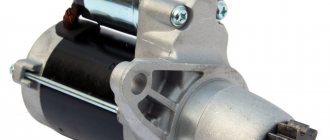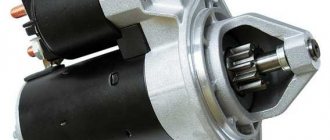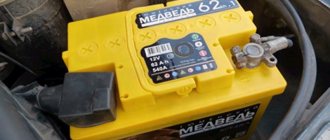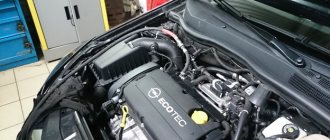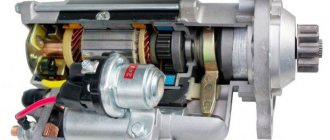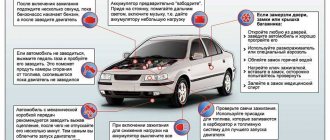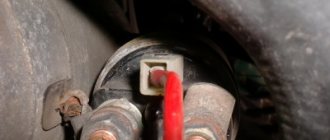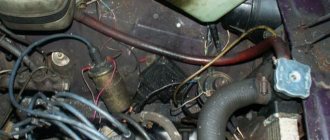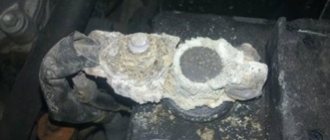The starter is one of the main links in the ignition system. The correct operation of this unit is responsible for starting the internal combustion engine. Reasons why the mechanism may fail: problems with the solenoid relay, discharged battery, opening of the ground contacts, ignition malfunction, violation of the integrity of the electrical wiring, etc. We will discuss the development mechanism, fault diagnosis and methods for eliminating them in more detail in the article.
Troubleshooting
You can often hear the phrase from car enthusiasts: “I get into the car, turn the key in the ignition, and nothing happens.” This occurs due to a breakdown of the starter unit or its electronics if:
- under the hood there are extraneous sounds (clicks, ringing, buzzing), but nothing happens;
- The engine will not start;
- The starter spins when starting, but the engine does not start;
- the crankshaft rotates slowly and the engine is silent;
- You can hear knocking noises under the hood, crackling gears and grinding noises.
How to start a car - the starter does not turn
If the starter is faulty due to the solenoid relay, then the car engine can be started if the contacts are closed forcibly. This is an emergency measure, but it is sometimes used when there is an emergency.
Let's look at an example of how to start the engine of a VAZ-2110 car.
- Place the gearshift lever in neutral position.
- Pull out the handbrake handle.
- Turn the ignition key and open the hood.
- Remove the air cleaner from its seat and move it to the side to provide access to the starter.
- Disconnect the plug from the contacts.
- Connect the two contacts of the pull-in relay together with a metal object or thick wire.
- If the other components are working properly, the engine should start.
Install the air filter and connect the wires. In many cases, the engine then starts without problems using the ignition key. But the problem has not disappeared, so you need to contact a workshop soon.
There is another method that is suitable for an urgent emergency start. It can only be used for cars with front-wheel drive and manual transmission.
Procedure:
- Raise the car with a jack so that one of the front wheels is suspended.
- Turn the raised wheel all the way.
- Wrap a rope or cable around the tire 3 turns, leaving an end 2 meters long.
- Turn on third speed.
- Turn on the ignition by turning the key.
- Pull the cable sharply, spinning the wheel and running away.
- After starting the engine, place the gearbox lever in the neutral position. You don't have to press the clutch pedal to do this. Wait for the wheel to stop.
- Use a jack to lower the car to the ground.
Attention!
The described method requires caution and safety measures. Otherwise, you may damage the vehicle and injure yourself.
This method is similar to starting with a handle on old cars, for example, Moskvich-412, or VAZ-2101. The raised wheel powers the gearbox and then the engine.
The most common causes of breakdowns
These are faults in the electrical circuit. These include:
- battery charge less than 12 V;
- oxidation of contacts;
- lack of current on the solenoid relay;
- breakage of the solenoid relay;
- wear of the brush assembly;
- armature commutator wear.
In the case when the retractor does not work and the starter is silent when the key is turned, the breakdown may be the result of a short circuit or open circuit to ground of the traction relay, or short circuit of the turn.
The culprit is electronics even if, when the ignition is activated and the engine starts, the flywheel disk rotates too slowly.
The mechanical causes of malfunctions can be judged by the lack of rotation of the crankshaft when the starter is working. When turning the key, the engine may not operate in the following cases:
- the slip clutch is broken;
- the release lever is faulty or disconnected from the axle;
- the buffer spring is worn out;
- Drive ring is broken or worn.
Why doesn't the starter turn?
The rotation of the motor shaft comes from the starter, which is a DC electric motor. If it does not work, then you need to find out the cause of the breakdown of the starting system.
Battery not charged
The following symptoms may occur when the engine does not start, depending on the battery charge level:
- No sounds can be heard. The battery is very discharged. If you turn on the lights, they produce a weak light and quickly turn off. The battery voltage can be diagnosed with a voltmeter. After charging the battery, you need to find out and eliminate the reason why the energy leak occurred.
- The retractor relay is activated, but the starter cannot crank the crankshaft. To diagnose a weak battery charge, you need to turn on the interior light. If the light goes out during startup, it is obvious that the battery charge is insufficient.
The malfunction can be eliminated by simply charging the battery, which can be done directly on the machine. To prevent electronic devices, such as alarms, from burning out, you need to remove the negative terminal. High power supply voltage can damage electronics. It is the negative contact that needs to be removed so that if the wrench accidentally touches the body, a short circuit does not occur.
Let's look at the case when the cooling fan is turned on and the car does not start. The battery is under load, so there is not enough voltage to turn the starter. If after charging the battery nothing changes, then the battery should be replaced with a new one. In addition, you need to monitor the density of the electrolyte.
Alarm problems
Sometimes it is impossible to start the car, the starter does not turn on, the battery is charged, the electrical circuit is fine. There is a possibility of malfunction of the immobilizer and alarm system. The nature of the breakdown does not depend on the make of the car and the year of its manufacture. In this case, you need to find out which model of anti-theft system is installed on the car.
A characteristic sign of a problem in the immobilizer is that the starter does not rotate, the engine does not start, and there are no relay clicks. Sometimes it happens like this - the car starts up, but immediately stalls. The engine may not respond to starting from the key fob or key. If at least one of these signs is present, then the starting system is blocked by the alarm.
Starter failure
It is not often that there is a problem with starting a car engine due to a malfunction of the starter itself. It is impossible to see the breakdown from the outside and you cannot do without a full inspection. Identifying the problem and fixing it usually takes a lot of time, money and effort.
Here is a list of the main breakdowns that occur in a starter device that has been in use for more than 15 years:
- Identification of a short circuit that caused the failure of the coils. A sign of a problem is smoke from the housing, the smell of burnt wires.
- Wear of the retractor relay parts, disruption of the bendix action. The starter does not connect to the engine flywheel and does not start it.
- Complete wear or breakage of the bendix teeth. The device is unable to start the engine.
- Burnout of electrical connections in the starter housing.
In many cases, it is not possible to repair the starter yourself. To do this you will have to contact the experts. But repairs will be carried out in the workshop if the bendix or solenoid relay is faulty. If the winding burns out, you will be advised to purchase a new starter.
But often starter breakdowns can be solved yourself. For example, drivers sometimes mistake a broken ignition switch for a faulty starter and buy a new one. Therefore, before repairing, you need to carefully check everything and find the exact cause.
Modern cars use special monitoring systems, making it difficult to check and find faults yourself. The operation of the starter is controlled by an electronic unit, so if it breaks down, it is recommended to contact a specialized service center.
Solenoid relay malfunction
When the battery is sufficiently charged and the alarm is turned off, but the engine does not start, the starter is faulty. If you hear metallic clicks when you try to start, then this is the work of the solenoid relay. It is faulty because it makes a knocking sound, the flywheel and bendix do not engage with each other and do not start the engine. You can check this failure of the solenoid relay and start the engine by closing two relay contacts with a screwdriver or wrench.
Attention! Before the procedure, you need to put the gearshift lever in the neutral position.
If the engine starts, then it is necessary to repair or replace the solenoid relay. The contacts, which are made in the shape of nickels, can burn in it. Drivers often believe that they cannot be repaired and can only be replaced. But temporarily the nickels can be restored. To do this, they are cleaned with sandpaper and installed in place. However, they have a protective coating that is removed by sanding. Therefore, after some time the procedure will need to be repeated.
Lack of contact in the starter circuit
Occurs as a result of metal corrosion or loosening of bolted wires. In addition, you need to check the grounding of the retractor and main relay of the starter assembly. You can check your car's electronics using a multimeter. Before doing this, inspect the wiring, tighten the bolts and check the terminals. If there is contact loss, restore their integrity.
Bendix failure
The starter clicks, the electric motor rotates, but the crankshaft does not turn
These are signs of a Bendix malfunction. Remember, its gear should rotate freely in one direction, and jam when you try to turn it in the opposite direction?
So, the cylinders that are in the overrunning clutch are not pressed against the outer race and the gear rotates freely in both directions. This means that when it engages with the flywheel, the Bendix cannot turn the crankshaft as it spins.
This is accompanied by the sounds of a running electric motor. It will work at high speeds, since nothing prevents it from spinning up to maximum values. If the bendix has not yet completely “died”, then this sign of malfunction will appear periodically . That is, today the starter started the engine, but an hour later it may not turn the crankshaft, but simply squeak at maximum engine speed.
Starting a car engine is accompanied by a terrible grinding noise.
This could be for two reasons:
- The Bendix did not engage the flywheel completely.
- The teeth on the gear or flywheel are worn.
In the first case, the bendix jams on the starter shaft. It is enough to disassemble it, clean the splines along which it moves, and lubricate them.
In the second case, only replacing the gear or flywheel. By the way, this malfunction does not appear immediately, but due to long-term use of the starter with poor engagement of the bendix and flywheel. That is, because of the first reason.
Why does the engine rotate inefficiently?
There are times when the starter works, but does not turn the engine with the required force. Let's list the situations when this happens:
- When using oil that does not correspond to the temperature conditions. The lubricant thickens and prevents the crankshaft from rotating. It is necessary to replace the lubricant with one regulated for the given weather conditions.
- Low battery charge. Does not provide energy for effective rotation. The battery needs to be recharged or replaced.
- In case of a malfunction of the brush assembly. It is necessary to check the contacts of the brushes and the tightening force of the tips going to the part.
Diagnosing a breakdown
So, the symptoms are obvious - the starter spins, but does not turn the engine. Of course, you can start a car from a tow, but it is reasonable to do this only if you need to get to the repair site. You won’t be able to start the engine this way all the time. First of all, pay attention to whether you hear any extraneous metallic sounds from the starter. If they are present, then the cause of the breakdown can be immediately determined - the teeth on the flywheel crown have worn out, so the Bendix gear cannot engage with them.
But there may be other faults. For example, a breakdown of the Bendix itself. Its main part is the overrunning clutch. With its help, the gear can only rotate in one direction. If it rotates freely in both directions, then the overrunning clutch is damaged. You only have to replace the bendix, and this procedure will take about half an hour. It is very rare that the metal plates or plastic plug are destroyed. If such a breakdown occurs, the starter spins, but the engine does not start, since the retractor relay closes the contacts, but does not engage the gears.
The mechanism does not function on a hot engine
The answer to the question of why the starter does not turn when hot lies on the surface. The bushings expand during engine operation, the unit begins to “wedge”, or it fails. As a rule, this problem occurs in cars with high mileage. Let's look at why this happens in the table.
| Cause of malfunction | Solution |
| Wear of standard bushings | Replacement |
| Bad contacts | Clean, tighten, treat contacts |
| Reducing the insulation resistance of the stator winding | Replace winding |
| Oxidized contact plates in the relay | Clean or replace |
| Foreign particles in the starter housing | Clean up |
| Brush assembly wear | Cleaning the brushes or replacing the unit |
Battery power problems
The following problems may occur in the electrical power supply and starter control circuits:
- The battery charge is only enough to activate the relay coil. After turning the key to the “start” position, a click is heard, but there is no buzz from the electric motor, and the lights on the dashboard dim. Sometimes a series of ineffective clicks is heard.
- There is a malfunction in the ignition switch or control relay. The Bendix clicks, but the starter does not engage.
- Poor contact in power circuit connections.
In the first situation, it is enough to charge or replace the battery for the starting device to start functioning. However, it is worth figuring out why the discharge occurred and eliminating the causes, otherwise you risk encountering a similar problem somewhere along the road.
Determining if the ignition switch or control relay is broken is quite simple: set the gear shift lever to the neutral position, take a thick wire and connect the “plus” of the battery directly to the power contact of the starter. The buzzing of the electric motor will indicate that the lock contact group or control relay needs to be replaced.
Advice. If the car does not start due to the ignition switch, you can start the power unit using the above method - turn on the ignition and connect the starting electric motor directly.
If the battery terminals are oxidized or there are other problems in the power circuit, the current is not enough to activate the starter, although power is generally supplied. Clean the terminals and other connections on the power cables to resolve the problem.
The part does not work either cold or hot
The reasons why the starter does not turn, does not start the vehicle and does not click may be:
- detachment of magnets;
- violation of the integrity of the contact group fuses;
- break in the control wire supplied to the starter. Carry out an emergency engine start. If it helps, the reason is in the ignition, if not, it’s in the wire;
- return spring failure.
For what reasons might a car not start?
From time to time, almost all motorists are faced with a situation where the starter does not turn the engine . And if you have at least a little experience in repairs, then in this case you can understand the cause of the breakdown yourself, and then eliminate it in order to at least somehow save on the work of the workshop. However, it is important to remember that there are a huge number of reasons why the engine still does not want to work. This means that you should use the elimination method, trying to eliminate the most common problems first. Moreover, each has its own signs, with the help of which you can accurately understand what is happening. As for a new car, most often the reason lies in the control system or ignition. If it’s used, then the problem is in the motor, which requires a mandatory overhaul.
A dead battery is usually the most common cause. There is simply not enough power in the battery to properly turn the starter and give sparks to the spark plugs. Moreover, this problem may be indicated by a dimly lit dashboard and non-functioning electrical equipment. Lighting up the car will help solve everything quickly, or you can also try starting the car with a pusher, and only then, when you are at home, recharge the battery well or replace it with a new one.
Another common problem is related to the gasoline supply. If there is no fuel supply or there is insufficient pressure in the rail, it means that the fuel pump is broken, the operation of which can be understood by an almost inaudible hum, as well as the buzzing of the pump when turning the key. In such a situation, you need to immediately change the fuel pump.
A broken generator causes confusion among many drivers. The main purpose of any engine generator is to generate electricity from the working engine in order to provide power to the on-board network and at the same time charge the battery. If the generator does not want to work, the battery immediately begins to discharge, and as a result the engine does not start. Therefore, it is first advisable to carefully check all its contacts, and only then the existing connectors, terminals and relays of the regulator.
Failure in the ignition system, unfortunately, is common. When car spark plugs reach the end of their intended lifespan, they simply stop igniting the gasoline in the cylinders, resulting in the engine not wanting to start. In addition, it is worth checking high-voltage wires, the problem of which can interfere with quality work.
Winter problems do not bypass drivers. In most cases, problems with starting the engine begin in the winter months, when all internal mechanisms are under high load. Indeed, due to low temperatures, the battery begins to discharge instantly, and a worn-out battery does not hold a charge well. And the oil may become thicker, thereby interfering with the normal operation of the moving force. In addition, an overly worn engine can easily lose compression, which does not provide any guarantee that it will be easy to start.
In a situation where the driver does not know why the starter does not turn , many questions arise. A starter problem is most often identified by characteristic clicking sounds instead of the sounds of a spinning engine. It is also possible that after turning the key there will be absolute silence, since nothing turned on. Perhaps the brushes with bearings have worn out, a short circuit has occurred or some contact has oxidized, which means urgent repairs are required.
The mechanism makes clicks but does not rotate
When the starter clicks once, but does not start the engine, this means that the unit requires repair. You need to try to start the car again. If it doesn't work, then it's probably the following:
- Bendix is broken;
- the starter winding is broken;
- a short circuit has occurred;
- the solenoid relay is faulty;
- brushes are worn out.
In this case, you need to replace the parts.
How to remove the gearbox
But everything is much worse if the starter spins, but does not turn the engine, and metallic sounds are heard. This means that you will need to remove the gearbox and replace the flywheel crown. Since you are going to climb here, remember how long ago you changed the clutch. If you don’t remember when, then purchase a kit - a disk, a basket, a bearing and six bolts. The procedure for removing the gearbox is not easy, so it is expensive to carry it out again. First of all, disconnect all the wires going to the gearbox and the speedometer drive cable. Now drain the oil, while simultaneously monitoring its appearance.
After this, disconnect the drives - remove the internal CV joints from the gearbox. Please note that both hinges cannot be removed at the same time! First dismantle the first one, then put a plug in its place. After that, just take out the second one. Otherwise, the differential will be destroyed, and you will have to disassemble the box to repair the damage. Then you hang up the engine and gearbox and remove the cushions. However, this is where the preparation is over. Now just unscrew the bolts or nuts that secure the box to the engine. And you can do the undocking.
How to replace Bendix
You can replace the Bendix in literally 10-15 minutes. With the condition that the starter has already been removed from the car and prepared for repairs. First, unscrew the rear cover fasteners, then remove the locking ring from the rotor. Unscrew the two nuts that secure the starter parts. But it can be disconnected only after the stator windings are disconnected from the brush assembly. When repairing starters, try to pay attention to all the details, even the smallest ones.
First, clean the slats and body. Secondly, evaluate the wear of the bushings and brushes. When you disconnect all the starter parts, the rotor will remain in the front cover. Closer to its edge there is a locking ring. A clip is placed on top of it, which can be moved towards the rotor winding by applying a few light blows. After this, use a screwdriver to remove the ring. That's all, now the bendix can be easily dismantled, and a new one can be installed in its place. It is recommended to coat the spiral splines on the rotor surface with lithol or graphite lubricant.
Checking the starter retractor relay
To determine the reason for the lack of connection between the gear elements of the starter and the engine, you should check the functionality of the solenoid relay. For ease of diagnosis, most often it is necessary to dismantle the entire starter.
However, before you begin dismantling the starter, it is advisable to carry out several simple operations that will help identify the problem:
- Check the condition of the battery, the reliability of the terminals, remove oxides from the battery terminals;
- Make sure that the electrical wiring is securely attached to the starter with nuts. If there is corrosion, clean the contacts with fine-grained sandpaper;
- Find the starter switch relay in the car and check its condition.
Starter removal procedure
To remove the starter, you need to disconnect the wires that go to it, and then unscrew the mounting bolts (usually two or three).
Often, to perform these seemingly simple operations, the motorist has to spend a lot of time and effort.
This is explained by the fact that the starter in many car models is well hidden in the engine compartment, and in order to get to it, it is necessary to remove many interfering components and mechanisms from under the hood. And in some cars, such as the Volkswagen Golf or Passat, engine support will be required to remove it.
It is best to carry out this work in a viewing hole or on an overpass.
How to check the starter solenoid relay
When the starter has been successfully removed from the engine compartment, it should be cleaned of dirt, and the oxidized contacts should be treated with sandpaper.
- Now the starter needs to be placed next to the battery and two electrical wires of sufficient length must be prepared. It is best to use wires for “lighting” that are equipped with “crocodiles”.
- The first step is to connect the positive terminal of the battery with one electrical wire to the corresponding terminal of the solenoid relay.
- After this, the other wire is connected to the negative terminal of the battery.
- All that remains is to touch the free end of the negative electrical wire to the starter housing and find out the result:
- if upon connection there is a quick and distinct click in the area of the solenoid relay, then it is working;
- if there are no signs of “life”, then the solenoid relay needs to be repaired or replaced.
If the solenoid relay is operational, the cause of the malfunction should be sought in the power circuit. Well, you can try to repair the faulty unit yourself or replace it with a new one.
Frequent malfunctions on popular cars
In most cases, the starter does not turn when the ignition key is turned due to oxidation and mechanical damage to the wiring. If there is poor contact with the “+” terminal of the battery, the control relay or ground, the starter does not receive enough current to crank the engine . Therefore, first of all, you need to look at the contacts in the engine compartment and check for voltage at the terminals with a tester. The most common malfunctions of specific car models, due to which the starter does not respond to the ignition key in the table.
| Why does the starter not work from the ignition key on popular car models? | |
| Auto | Weakness |
| VAZ 2110, 2111, 2112 | Wires of the central locking and ignition switch, which melt due to power surges. |
| VAZ 2108, 2109, 21099, 2113, 2114, 2115 (Lada Samara) | Oxidizing contacts of the control relay located in the engine compartment above the VUT, as well as the wiring extending from it. |
| VAZ 2101, 2102, 2103, 2104, 2105, 2106, 2107 (Classic) | The contact “nickels” of the solenoid relay often burn or oxidize. The contact group of the ignition switch fails. On later models, for example, 2107, problems with the control relay are similar to Samara (see above). |
| Niva | On old Nivas (before 21213), the ignition switch contacts burn and oxidize. On newer ones (after 21214), the starter control relay, located under the hood near the brake fluid reservoir, often fails. There is a drainage tube located nearby that drains water from under the glass, moisture from which gets onto the relay, which leads to oxidation of its contacts. |
| Lada Priora | Immobilizer problems due to which it does not see the key. |
| Lada Kalina, Lada Granta | Failure of the immobilizer, blocking the start, malfunctions in the contact group of the ignition switch and failure of the additional starter relay K3 in the fuse block. |
| UAZ | Malfunction of the 5-pin starter control relay and solenoid relay. |
| Gazelle | Poor contact of wires and failure of the starter relay. |
| Peugeot 307 | Solenoid relay fuse F8 blows, poor ground contact. |
| Kia Sid | The limit switch of the automatic transmission selector, which determines the P and N positions, is faulty. There may be poor contact at the starter terminals or at the point where the ground wire is attached to the body. |
Typical solenoid relay malfunctions and their symptoms
Open or short circuit in the control circuit. They can happen on any segment - from the ignition switch to the terminal on the VR housing. This category includes: wear of the contact group of the lock itself, a blown fuse, a closed locking relay, a short circuit in the wiring harnesses, oxidation of the terminals in the blocks. Failure manifests itself in different ways. More often - a complete lack of response from the device to startup attempts. Sometimes the starter only clicks at first until the battery runs out.
Burning of the contact group inside the device, due to which a large current does not flow to the brushes of the electric motor, and it does not rotate. Loss of conductivity due to carbon deposits, oxidation of the coins, a broken plate or a plate that has moved out of place is the second most common problem with the starter relay. With such malfunctions, the starter sometimes clicks, but does not turn the gear.
Burnt wires and oxidized contacts of the retractor relay
A break in the holding winding at the point where it is attached to the body - due to which, instead of one operation, a whole “cascade” of useless clicks is heard. Bendix does not have time to engage with the teeth of the flywheel - it is immediately thrown back. At the same time, the car gives a clear picture of short “idle” clutch activations with knocking, howling, crackling or buzzing. The case does not quite fit the definition: “the relay clicks, but the starter does not turn,” but refers purely to the breakdown of the solenoid relay.
VO short circuit - with this breakdown, the starter clicks, but cannot completely push out the bendix and supply power to the lower power bolt (to the brushes). The malfunction is detected only when removed from the car and the coils are checked one by one.
Popular brands: Infiniti QX80

